Japanese Art, National Treasures of Japan
Japanese Art’s Most Famous Winter Scene? My Amateur Vs Professional Review of Maruyama Ōkyo’s “Pine Trees in the Snow”
The beautiful snow-capped branches of the delicate Japanese matsu pine tree; images of Kyoto in winter are almost never without this iconic tree. But it’s not just Kyoto that is home to these evergreens. No, in fact, scenes from Kanazawa to Tokyo are filled with these carefully dusted, age-old trees. So central to the image of the Japanese natural environment is the pine that you are almost guaranteed to find one featured in Japanese gardens from here to Brazil. Many more grow in tiny pots in small apartments all over Japan as bonzai trees. The dusting of fresh snow on a Japanese pine is said to represent a new start, often the coming of the new year.
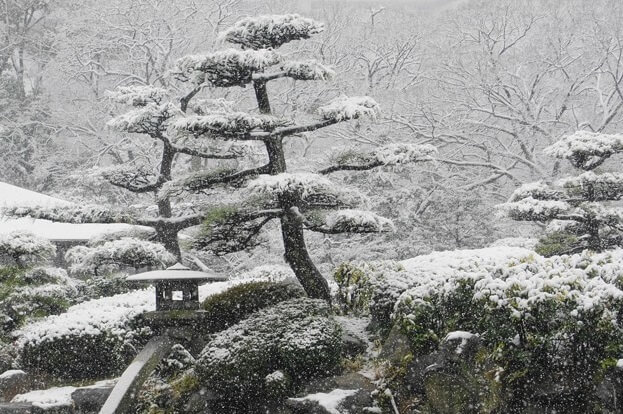
(Image: photozou.jp)
As the Japanese pine remains ubiquitous with peaceful scenes of that country’s natural environment, it comes as no surprise that master Japanese artists have been incorporating their ancient beauty into their work for centuries. Today’s subject is perhaps the most famous and valued depiction of a Japanese pine ever created. Yes, I am talking about Maruyama Ōkyo’s Yuki-matsu-zu Byōbu – the “Pine Trees in the Snow Folding Screen.” Today we are going to put it the snow and gold-dusted branches of Maruyama’s pines through our Amateur Vs Expert review system.
In order to provide a full-featured take, I’m going to start, as I always do, with an overview of the artist, context, and period before launching into my blind review. I don’t know about you, but this series has already taught me a lot – I think I’m getting closer understanding what the art history professors and critics see in these works, picking up themes and noting the influences of each era and artist. Today’s work is the ‘youngest’ of the bunch so far, so maybe we can put together a bit more of the puzzle that is the evolution of early-modern Japanese art! Let’s get started.
Who in The World Was Maruyama Ōkyo?
Remember Carmen Sandiego? Pretty proud of that subtitle – it even has the same amount of syllables! 90s kids can probably sing it, right? “Where Who in the World Was Maruyama Ōkyo?”
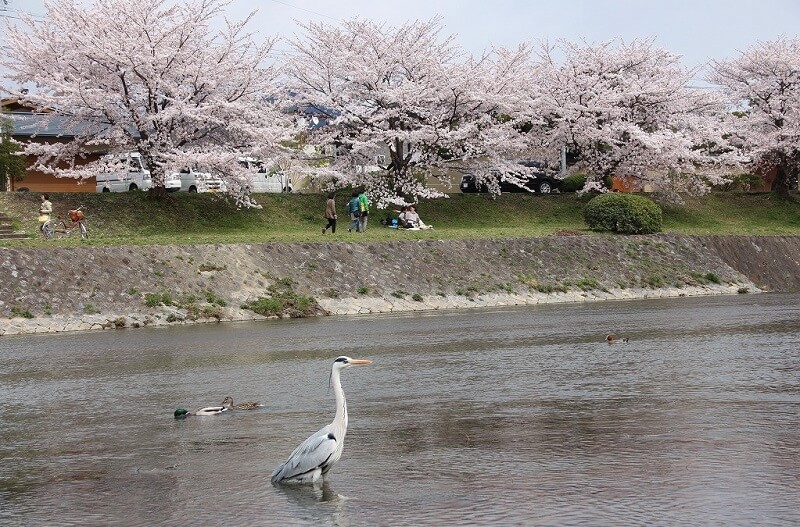
(Image: nacos.com)
Maruyama was born near modern day Kameoka in Kyoto. He soon moved to Kyoto city and began his practise, eventually leading to the formation of a Maruyama school, a distinct sub style of the Kyoto school which dominated this era and continues to enjoy lasting influence in Japan today. Popular themes include the natural world, as well the cranes and flowers native to the Katsura and Kamo Rivers in Kyoto. So dedicated was Maruyama to the artistic recreation of these scenes, that he was later criticized by rival artists for being too interested in simple reproduction. See this ‘comic’ from the early Meiji period, drawn to make fun of a Maruyama who has drawn a ghost so realistic that it scares even himself.

(Image: en.wikipedia.org)
Despite these criticisms, Maruyama is credited with being one of the earliest painters in Japan to mix influences of Western realism (or naturalism), with Japanese trends of design balance and decoration. Drawing from his training in Chinese artistic traditions, he added the effective use of gold paints to add extra power to his scrolls and screens. In this way, Maruyama’s work can be seen as a balanced mixture of the available materials, genres, and methods available to him in late-1700s Kyoto. It with these techniques that he took up the Mitsui merchant-family commission to decorate a pair of six-panel folding screens with a winter scene – a work would become his masterpiece.
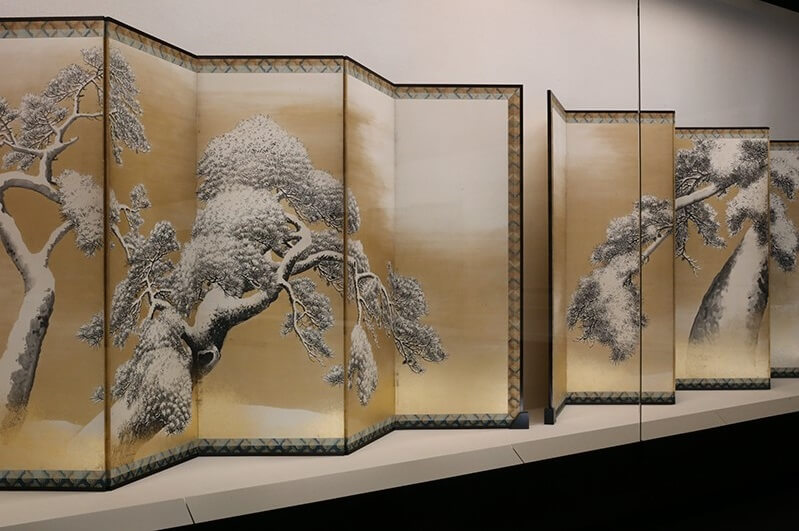
(Image: museum.or.jp)
Like last time, today’s subject is one of Japan’s certified National Treasures (Kokuhō). Important note: The Mitsui conglomerate who hired Maruyama is still around today. One of the largest corporations in Japan, Mitsui runs an art gallery in Tokyo which houses and exhibits this Maruyama screen.
Enchanted by the Gold and Whites: Jay’s Amateur Reading
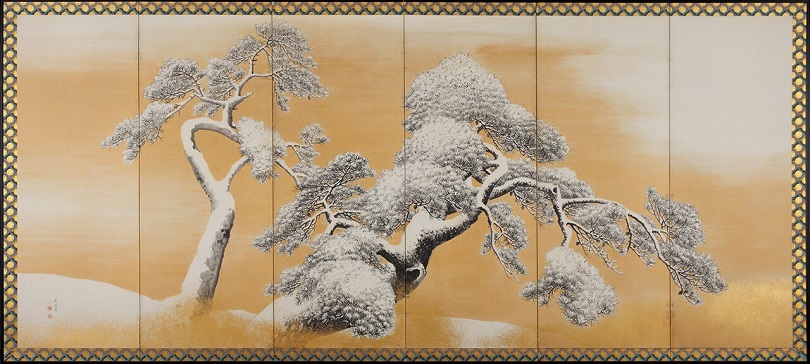
Starting on the left and working right, I notice right away the snow clumped around the base of the trees. This helps ‘ground’ the piece and establishes our perspective, I think, putting us up close at the front of these pines. And yet, the roots are not visible, and the actual height of these trees is ambiguous. These aspects add a touch of the ‘floating’ sense. Meanwhile, the mainly blank background – blank aside from some cloud or snow-like bunches – guides our focus toward the shape and stance of these two pines.
The use of gold paint and sumi ink makes each of the three colours or shades involved ‘pop’ on their own. The white, which looks like it might be the areas of paper left uncovered, are contrasted effectively but the vivid golds and blacks. This helps establish the frame and borders as a part of the piece, highlighting the importance of those Kyoto craftsmen framers we discussed a few weeks ago here at OrientalSouls. (LINK)
I want to focus on the balance between the two panels: the left is a low, almost laterally moving pine, while the right is a taller tree reaching beyond the upper borders of the panels. Perhaps right pine is a more mature, older tree. It certainly gives off a more ‘wise’ or ‘experienced’ aura. With no other trees around, it is possible this scene reflects the manicured, cultivated layout of one of Kyoto’s many Japanese gardens. Or, perhaps it is a reflection of the very same natural beauty these gardens are themselves inspired by.
Either way, it is the seemingly random spread of the wise pine’s branches and needles that takes center stage here, complimented by the fresh whites of snow and the golden aura of a blissful morning scene. Wait a minute … is anyone else reminded of Kyoto’s Kinkaku-ji Golden Pavilion in winter?
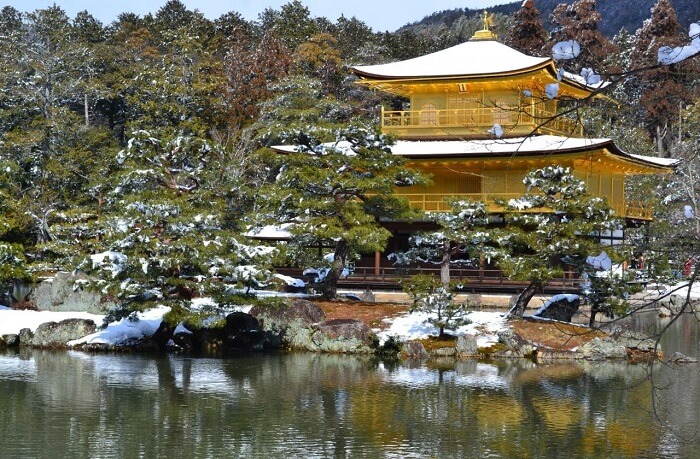
(Image: 4travel.jp)
I am close? Do I see what the experts at the Mitsui Memorial Museum do? What about the experts and fans at arts schools and cafes around the country? Let’s compare my amateur reading with what the experts have to say.
The Expert’s Take

As one of the country’s most famous byōbu folding screen, there have been pages and pages, books upon books written about Maruyama and his innovative sumi-e ink wash paintings. I’ve distilled down the main points for us here today. First, the balance between panels: it turns out experts appreciate the differences of the two trees just like me. The taller tree on the right they identify as an older, mature pine – the left a younger, newer tree. Youthfulness and vigour on the one hand; knowledge, experience, and respect on the other. What’s more, experts point to the important meaning of the matsu pine in greetings of good luck, longevity, along with the expressions of ‘newness’ or ‘rebirth’ made by fresh snow in Japanese art and culture. Experts note the central role this piece plays in the Mitsui Museum’s New Years’ festivities.
Perhaps most important is the way the trees’ shapes are more defined by the contrasting golden backgrounds and the snow which partially covers than by strokes of black ink used to outline the tree itself. This, the experts say, adds to the softness of their appearance, and makes the most of the whiteness of the paper beneath – I was right to notice the white as the exposed canvas washi Japanese paper! Clear, black, determined strokes are limited to the pine needles appearing only at the tips and edges of these majestic trees. I am glad to have picked up on that by myself.
The gold around and beneath the trees is said to represent the light of the morning sun as it reflects off the snow dusted surroundings. Though moments like this are fleeting in real life, these panels allow us to enjoy a tranquil morning amongst the snowy pines any time of day at any time of year. This is why Maruyama’s piece would have been such a hit in a Mitsui family member’s parlour, where guests would sit amongst them while enjoying a tea or meal.
A Japanese Nation Treasure of Timeless Beauty
For those of us from countries without such delicate, short pine trees, their image is one that appears uniquely ‘Japanese.’ More specifically, and for all their use in canonical Japanese visual art, these pines scream ‘Kyoto’ to me. Meanwhile, it demonstrates many of Maruyama’s most distinct characteristics – the aspects of his art for which he is remembered, enjoyed, and studied today.
Stay tuned to our blog for even more of this series, as we cover both the amateur and experts’ take on some of Japan’s most famous arts and crafts. Until next time!

Author - Jay
In my spare time I enjoy watching baseball, tasting local cuisine, and exploring by road and rail. Having lived in several cities around the world, I have an appreciation for local as well as international histories and cultures. Excited by cultural and social exchange, it is my hope that this blog will help promote an interest in Japanese traditional wares and practises by introducing you to their history and meanings.

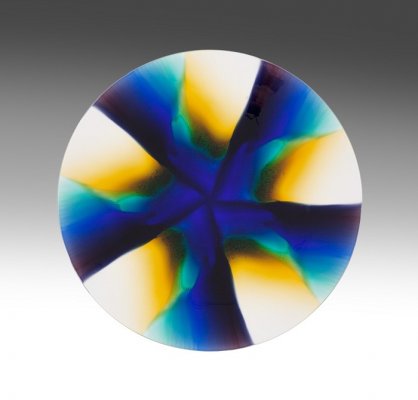
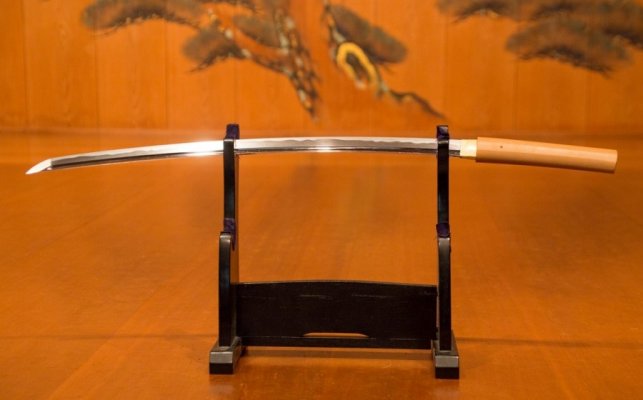
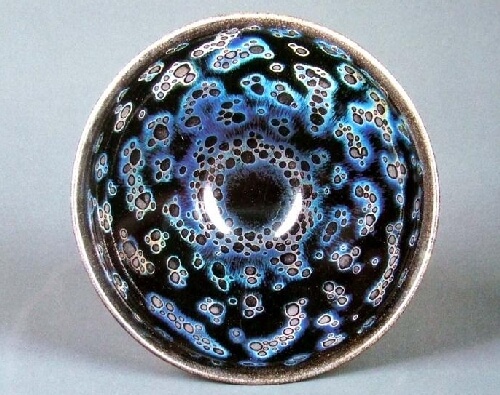
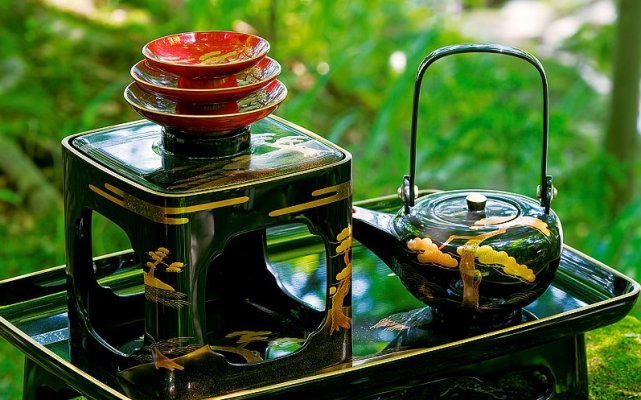


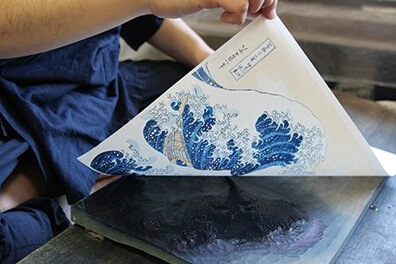
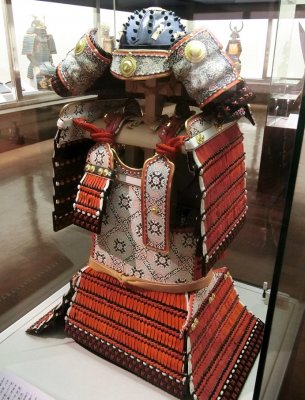
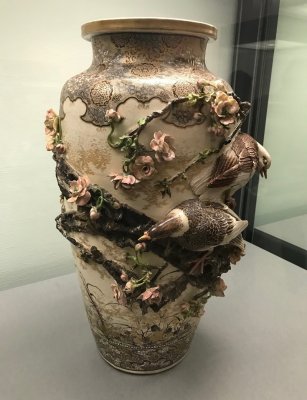
About Orientalsouls.com
Learn and Buy Japanese Craftsmanship, Tradition & Culture
OrientalSoul.com is the online shop where you can buy traditional crafts of Japan.
We only sell selected authentic products in which true spirits of Japanese craftsmanship exist.
You may be able to find similar products in other shops for lower prices. However, we sell products based on fair prices that worth labor and value of experienced craftsmen.
In addition, we introduce stories about product history, how a product is made, what makes it different from others, and how the product enriches your life!